Key takeaways:
- Community housing development empowers residents through collaboration, fostering a sense of belonging and strong support systems.
- Building effective resource networks enhances community resilience and facilitates invaluable connections for personal and communal growth.
- Engaging community members through inclusive environments and leveraging both local events and digital platforms enriches participation and idea exchange.
- Documenting experiences and reflecting on successes and challenges are essential for transparency, learning, and continuous improvement in community initiatives.
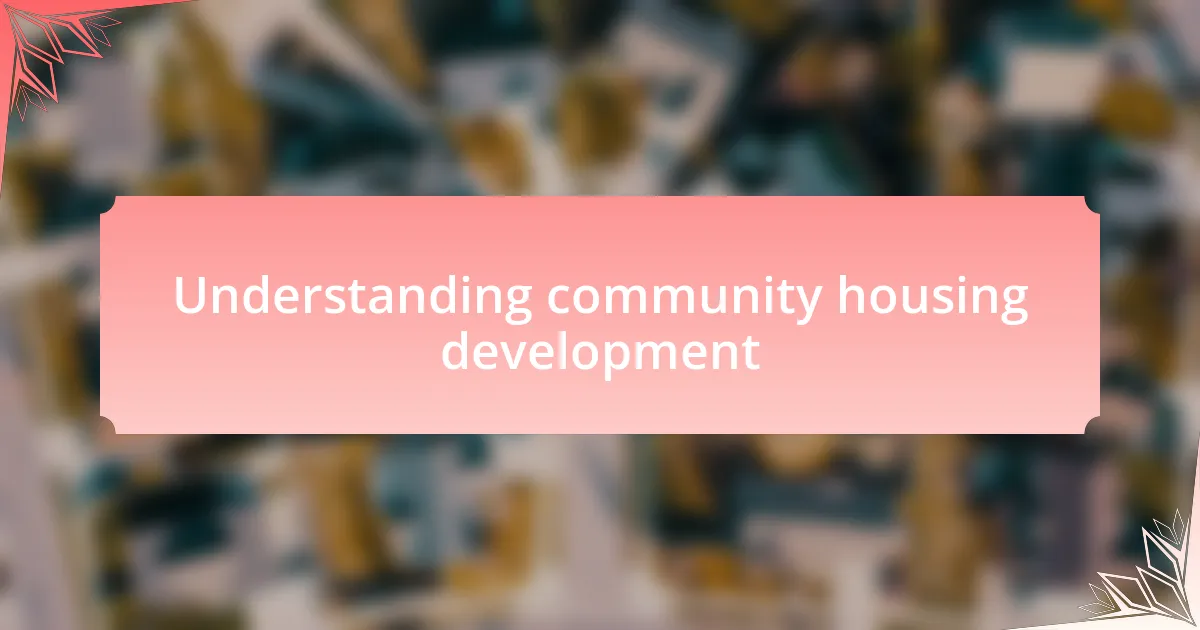
Understanding community housing development
Community housing development plays a pivotal role in addressing housing insecurity and promoting inclusivity. I remember visiting a community housing project where families from diverse backgrounds participated in designing their homes. It struck me how empowering this process was; it wasn’t just about building houses, but about creating a sense of belonging.
When I first learned about community housing, I was surprised to discover how it fosters cooperation among residents. Can you imagine a neighborhood where everyone knows each other and works together for common goals? I’ve seen firsthand how communal gardens or shared spaces can transform a block from a series of buildings into a thriving community, where relationships flourish and support systems are built.
Understanding community housing development is crucial, as it encompasses more than just physical structures. It’s about people—their stories, aspirations, and connections. I often reflect on the resilience I’ve witnessed in these communities; how they turn challenges into opportunities for growth, making them not just homes, but vibrant ecosystems of support. Wouldn’t you want to be part of such a dynamic and nurturing environment?
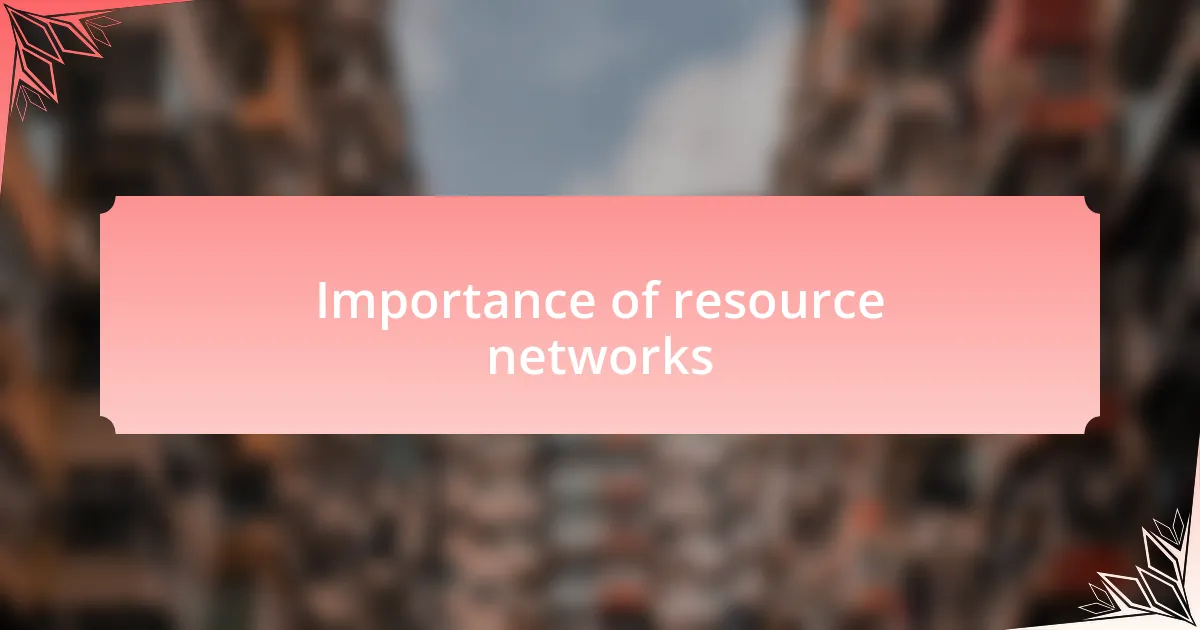
Importance of resource networks
Resource networks are essential because they serve as the backbone of support within community housing. I recall a time when I was involved in a project that connected local businesses with residents looking for job opportunities. This synergy created a ripple effect, where both the community and businesses thrived. It made me realize how crucial these connections are; without them, people miss out on invaluable resources that can transform their lives.
Having a strong resource network can greatly enhance a community’s resilience. For instance, during a difficult winter storm in our area, a network I was part of quickly mobilized to deliver food and necessities to those in need. In moments like that, you can truly feel the power of collaboration. Isn’t it inspiring to see people come together for a common cause? It reinforces the idea that shared values can lead to profound impacts, particularly in times of crisis.
Moreover, resource networks foster a sense of belonging. I remember attending a community meeting where someone shared their struggle finding affordable childcare. It sparked an incredible conversation, leading to the creation of a co-op that alleviated the burden for many families. This experience highlighted how intertwined our lives can be when we leverage our network; it’s not just about individual needs, but about lifting each other up and creating a supportive environment for all.
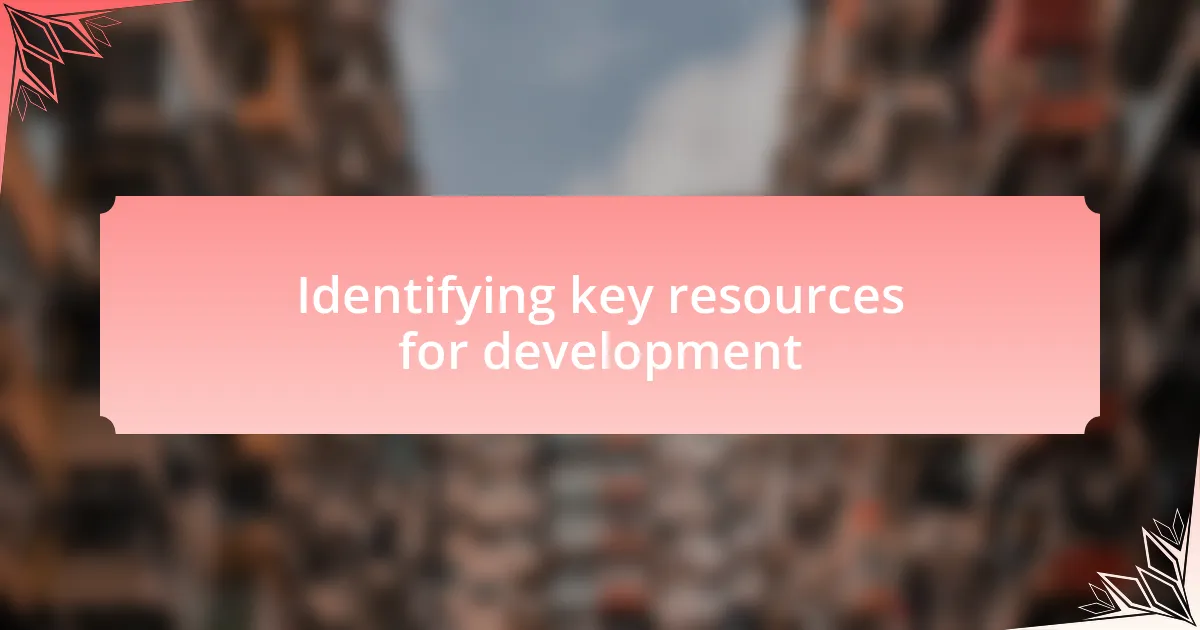
Identifying key resources for development
Identifying key resources for development begins with a clear understanding of the community’s unique needs. I once initiated a project where we conducted surveys to gauge what residents felt was lacking. It surprised me that many had a wealth of skills but lacked access to workshops or mentorship programs. By recognizing these insights, we were able to develop tailored resources that directly met their needs, fostering both personal and communal growth.
Next, it’s important to tap into local organizations and agencies that already have established networks. During another community initiative, we partnered with a nonprofit dedicated to youth development. Their expertise and connections helped us launch a housing skills workshop, which turned out to be a game-changer for many participants. Collaborating with such resources not only amplifies our reach but also enhances credibility—do you ever think about how much we can achieve when we join forces?
Finally, personal relationships play a pivotal role in resource identification. I remember striking up conversations at local events, where I discovered individuals with skills and passions aligned with our housing goals. Each interaction opened doors to new possibilities; it made me realize that sometimes the best resources are right next to us, waiting to be discovered. Isn’t it fascinating how a simple chat can lead to lasting partnerships that enrich the community?
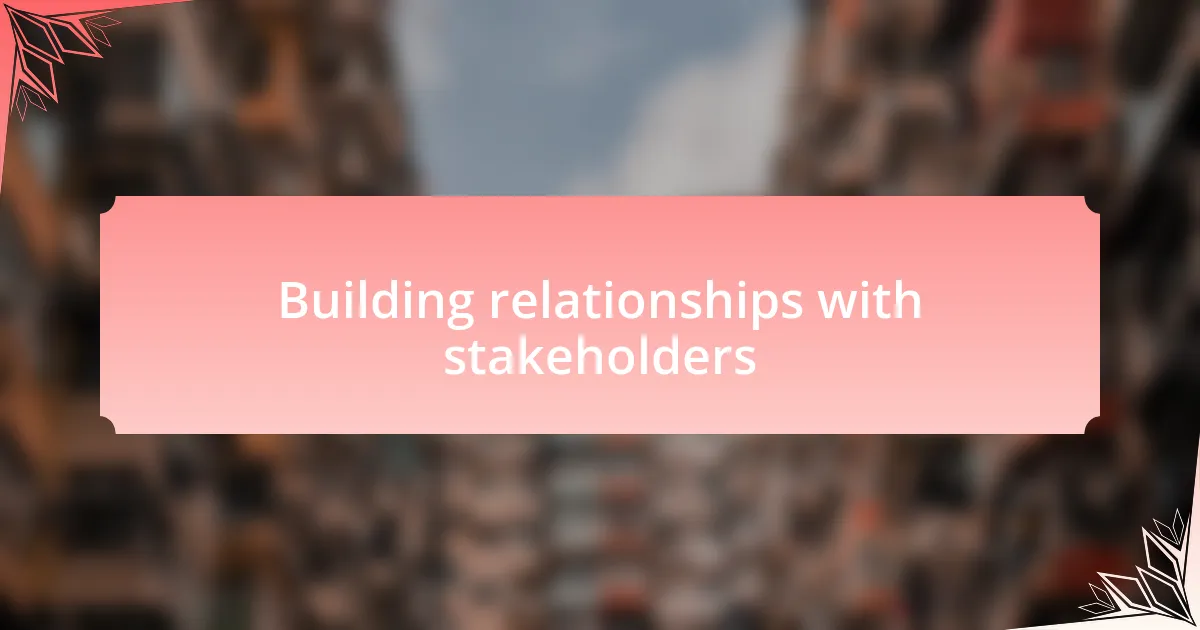
Building relationships with stakeholders
Building relationships with stakeholders is all about trust and communication. I remember attending a community meeting where I made it a priority to listen rather than just talk. By genuinely understanding the concerns of residents and local leaders, I was able to build relationships that later translated into collaborative efforts for housing projects. Does listening not often lead to deeper connections than sharing our own agenda?
As I navigated through one particular initiative, I found that involving stakeholders from the initial planning stage was crucial. We held brainstorming sessions where everyone could voice their ideas and concerns. I was taken aback by how these conversations not only cultivated a sense of ownership among participants but also unearthed innovative solutions. Don’t we all want to feel like our contributions matter, especially when it comes to the spaces we inhabit?
It’s also essential to maintain those relationships over time. I made it a habit to send follow-up emails or schedule catch-up coffee chats, because I believe that a gesture of appreciation goes a long way. Those little efforts made stakeholders feel valued, making them more likely to lend their support when we faced challenges. Have you considered how small acts of kindness can fortify the foundation of your community network?
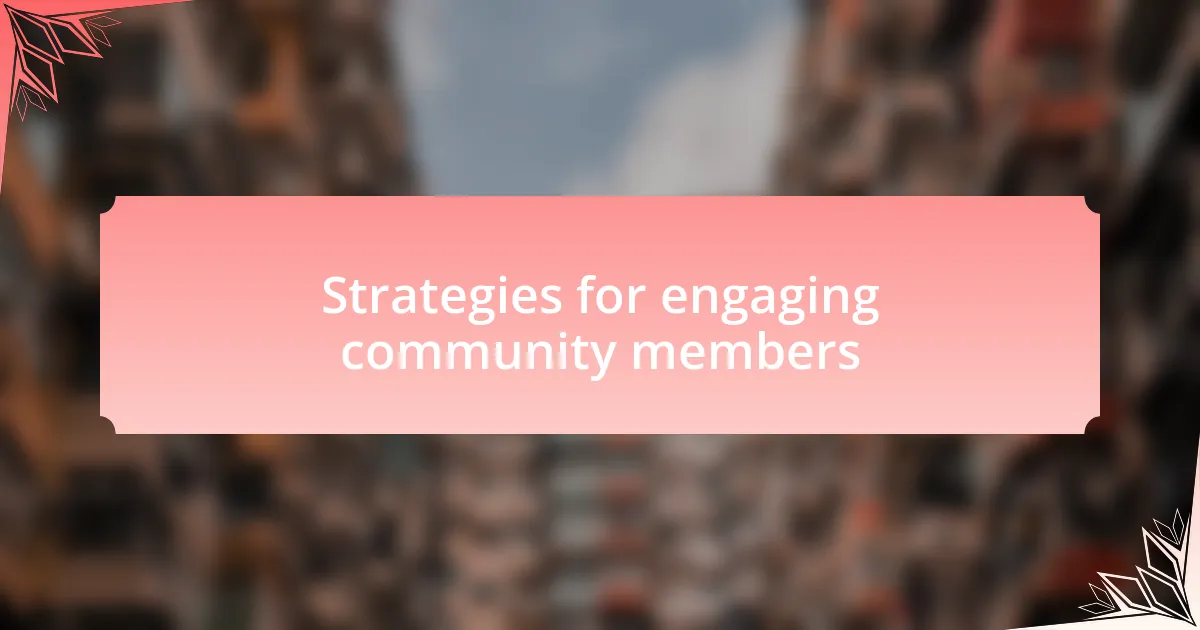
Strategies for engaging community members
Engaging community members starts with creating a welcoming environment where everyone feels comfortable sharing their thoughts. When I organized community workshops, I made sure to include activities that encouraged participation, like group discussions and interactive games. The energy in the room was palpable; it transformed hesitant voices into eager contributors. Isn’t it amazing how a little collaboration can dissolve barriers?
Another strategy I found effective was leveraging local events to foster connections. By setting up informational booths at festivals and fairs, I could interact with community members in a relaxed setting. One time, a resident approached me with a unique housing idea sparked during our chat. I never would have imagined that informal exchanges could lead to such valuable insights. Can casual conversations truly shape the future of our neighborhoods?
Lastly, using digital platforms has been a game-changer in keeping the dialogue going beyond face-to-face interactions. I started a community newsletter that not only shares updates but highlights resident success stories. After featuring a local family who turned a vacant lot into a community garden, I received an influx of engagement online. How often do we underestimate the power of digital storytelling in bringing people together?
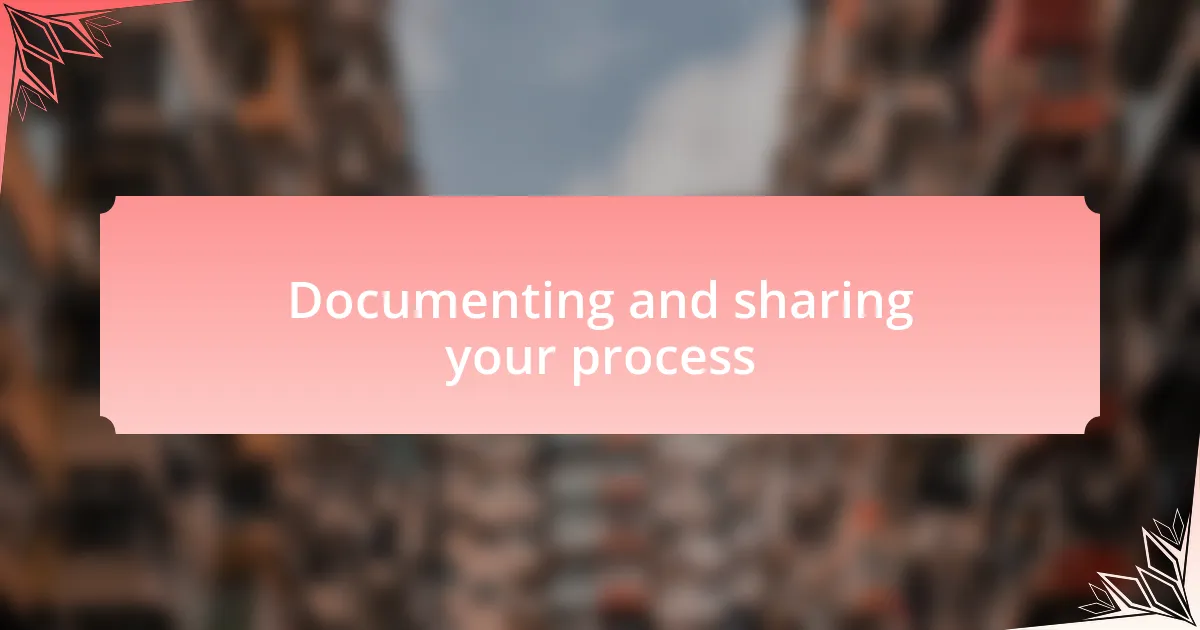
Documenting and sharing your process
Documenting the steps in creating a resource network is crucial for transparency and learning. I found that keeping a detailed journal of my journey not only helped me track progress but also revealed patterns and insights I hadn’t noticed before. Have you ever thought about how writing things down can connect all the dots for you?
Sharing this process with others was equally important. I decided to create a blog where I uploaded bi-weekly updates on my progress, including both successes and setbacks. When I received feedback from readers who had similar experiences, it felt like building a community of support. Doesn’t it feel rewarding to know others are on the same path?
Visual aids played a significant role in my documentation as well. I started capturing photos of our developments and creating infographics that illustrated milestones and resources. The first time I shared a timeline showcasing our achievements, it sparked a lively online discussion. How much more compelling is information when it’s visually engaging?
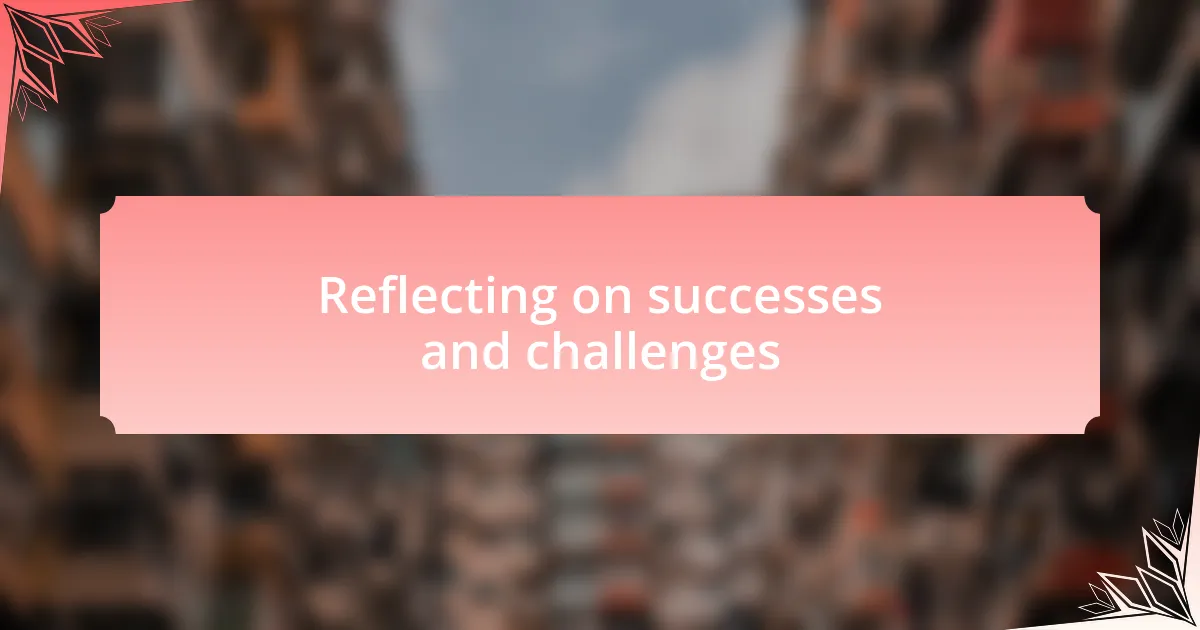
Reflecting on successes and challenges
Reflecting on successes feels like taking a moment to bask in the glow of hard work. I remember the day we successfully connected my first group of community members to housing resources. There was a real sense of accomplishment, a realization that our efforts were making a tangible difference. Can you imagine the joy of knowing that your work directly impacts people’s lives?
However, the journey wasn’t without challenges. I faced numerous setbacks, from unresponsive contacts to sudden changes in project timelines. I recall one instance when a critical meeting fell through, leaving me feeling deflated. But adversity often teaches us valuable lessons, doesn’t it? Those moments of struggle pushed me to adapt and innovate, ultimately strengthening the network.
I’ve learned to embrace both the highs and lows equally. Acknowledging every success, no matter how small, builds momentum. It’s essential, too, to analyze what went wrong and how we can improve. This dual reflection helps to maintain resilience. How can we grow if we don’t examine both sides of the coin?